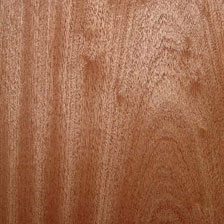Kosipo

Other names
West African cedar, Atom-Assie, Omu
Scientific Name
Entandrophragma candollei
Family
Meliaceae
Description
The wood is red brown with purplish glints. It darkens with light. Deposits of black resin in the pores. Ribbon like aspect on quartersawn. It has clearly demarcated sapwood. The grain is straight or interlocked and the texture is coarse. Quarter-sawn surfaces are slightly striped. Kosipo is moderately durable, being liable to powder-post beetle, pinhole borer and marine borer attacks and moderately resistant to termites. The heartwood is resistant to preservatives and the sapwood moderately resistant
Density
(H=12%) : 0,69
Treatability
poorly permeable
Seasoning
It air dries slowly and is liable to distortion.
Stability
moderately stable
Durability
moderately durable
Workability
The wood saws fairly easily although it requires some power, and it works easily with both hand and machine tools. It usually contains silica (up to 0.5%) and has moderate blunting effects on cutting edges; stellite-tipped saw teeth and tungsten-carbide cutting edges are recommended. In planing and moulding operations a 15–20° cutting angle is recommended, especially when interlocked grain is present. It can be finished to a nice surface, but the use of a filler may be required. The wood is not liable to splitting on nailing and screwing, and has good holding properties. The gluing, staining and polishing properties are good when a filler is used. The steam bending properties are poor. The wood is suitable for the production of sliced veneer.
End-Uses
- Exterior joinery
- Interior joinery
- Sliced veneer
- Cabinetwork (high class furniture)
- Interior panelling
- Current furniture or furniture components
- Veneer for back or face of plywood
- Flooring
- Stairs (inside)
- Exterior panelling
- Shingles
- Light carpentry
- Glued laminated